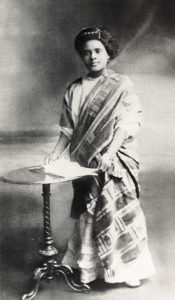
Gladys May-Hayford
*Gladys May Casely-Hayford was born on this date in 1904. She was a Black African writer.
Born in Amix, Gold Coast, she was the daughter of the Visionary Pan-Africanist and African lawyer J.E. Casely-Hayford and African Victorian Feminist Adelaide Smith Casely-Hayford. As a child, Hayford (Aquah LaLuah) didn't like textbooks or arithmetic, but she was a voracious little reader, devouring Kingsley's "Heroes" from cover to cover at seven. Hayford went to primary and secondary school in Ghana and went to college. She also studied in Wales, danced with a Berlin jazz band, and returned to Africa to teach at her mother's Girls' Vocational School in Freetown.
At the school, she taught African Folklore and Literature, and that Black Africans were not inferior but equal through her poetry. She spoke both English and Creole fluently and was also a Creole poet. Hayford was an accomplished writer, musician, dramatist, painter, and storyteller. Her writings had profound African roots, and Anthologists of the Harlem Renaissance loved her work. She was an influential poet during that period because she wasn't afraid to be herself and express herself through her writing.
Creating something new and creative became an essential theme for the Roaring 20s, pushing it to new heights and attracting many tourists. She wrote many inspiring and great works. Her first poems were published in the Atlantic Monthly and The Philadelphia Tribune. Her poetry has been widely anthologized, such as Nativity (1927), The Serving Girl (1941), and Creation (1926). She lived in Freetown, Sierra Leone, for much of her life. Gladys May Casely-Hayford (Aquah LaLuah) died of blackwater fever in 1950.